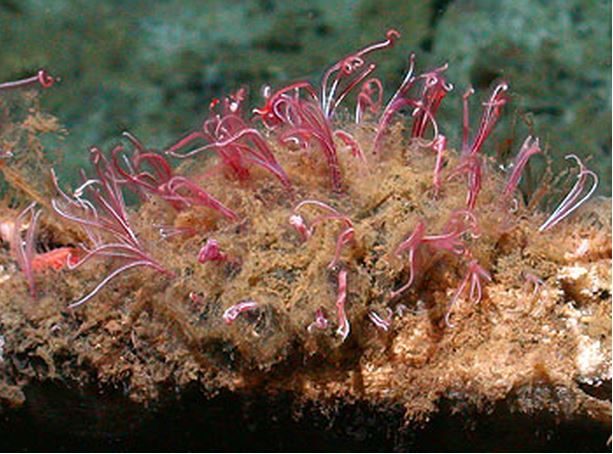The Osedax worm, known informally as the Zombie Worm, is a species of bone-eating worm that scientists mistakenly believed evolved in conjunction with whales. It has been dated back to at least 100 million years ago, when it fed on the carcasses of huge marine reptiles.
Scientists at the School of Geography, Earth and Environmental Sciences, and the Marine Institute, both at Plymouth University in England, wrote in the academic journal Biology Letters (citation below) that Osedax worms subsisted on the bones of prehistoric reptiles, such as sea turtles and plesiosaurs.
Authors Dr. Nicholas Higgs and Dr. Silvia Danise revealed how they found tell-tale traces of the Zombie Worm on plesiosaur fossils held at the University of Cambridge Museum.

Scientists from the Monterey Bay Aquarium Research Institute first discovered the Osedax worm in Monterey Bay, California, in February 2002. Here, they are seen feeding on a whale bone. (Image: Monterey Bay Aquarium Research Institute)
According to Dr. Higgs, the discovery was important for both understanding the genesis of the species and also its implications for fossil records.
Osedax did not co-evolve with whales
Dr. Higgs said:
“The exploration of the deep sea in the past decades has led to the discovery of hundreds of new species with unique adaptations to survive in extreme environments, giving rise to important questions on their origin and evolution through geological time.”
“The unusual adaptations and striking beauty of Osedax worms encapsulate the alien nature of deep-sea life in public imagination. And our discovery shows that these bone-eating worms did not co-evolve with whales, but that they also devoured the skeletons of large marine reptiles that dominated oceans in the age of the dinosaurs.”
“Osedax, therefore, prevented many skeletons from becoming fossilised, which might hamper our knowledge of these extinct leviathans.”
No mouth or digestive system
The Osedax worm, about the length of a human finger, can be found in oceans across the planet at depths of up to 4,000 metres. It belongs to the Siboglinidae family of worms, which lack a digestive system and mouth as adults.
They penetrate bone using root-like tendrils through which they absorb lipids (fats) and bone collagen, which are then converted by bacteria within the worm into energy.
They typically consume the bones of whales, a fact that prompted a number of scientists to suggest that they co-evolved 45 million years ago, branching out from their cousins that used chemosynthesis to obtain food.
However, in this latest study, the researchers studied fossil fragments taken from a sea turtle found in Burham in Kent, and a plesiosaur unearthed in Cambridge.
Using the Natural History Museum’s computed tomography scanner (a 3-D X-ray machine), they were able to create a computer model of the bones, and found the hallmark bore holes and cavities consistent with the Osedax worm’s burrowing technique.
Dr Danise said:
“The increasing evidence for Osedax throughout the oceans past and present, combined with their propensity to rapidly consume a wide range of vertebrate skeletons, suggests that Osedax may have had a significant negative effect on the preservation of marine vertebrate skeletons in the fossil record.”
“By destroying vertebrate skeletons before they could be buried, Osedax may be responsible for the loss of data on marine vertebrate anatomy and carcass-fall communities on a global scale.”
“The true extent of this ‘Osedax effect’, previously hypothesized only for the Cenozoic, now needs to be assessed for Cretaceous marine vertebrates.”
Citation: “Bone-eating Osedax worms lived on Mesozoic marine reptile deadfalls,” Silvia Danise and Nicholas D. Higgs. Biology Letters. Published 15 April 2015. DOI: 10.1098/rsbl.2015.0072.
Video – Boneworms on dead whales
This 2009 video, by the Monterey Bay Aquarium Research Institute, talks about the Osedax worm.
